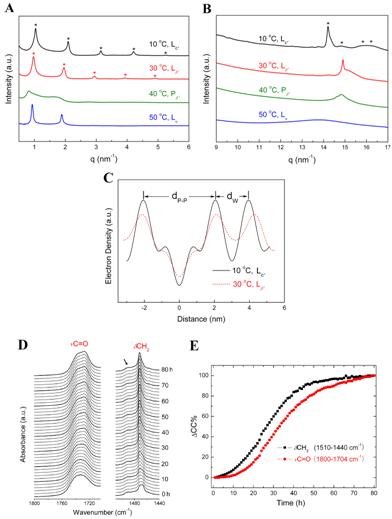| Triggering Mechanism in Phase Transitions of Phospholipids |
| From: PublishDate:2012-06-26 Hits: |
Phospholipids are the most ubiquitous structural elements of biological membranes. The vast majority of lipid molecules are comprised of a hydrophilic headgroup, a glycerol backbone, and two hydrophobic hydrocarbon chains. Due to their amphiphilicity, phospholipids represent an important class of soft matter and can self-assemble into various ordered structures. Although numerous efforts have been made to unveil the various aspects (such as phase stability, phase diagram, and morphology) of the phase states of phospholipids, some long-standing and challenging questions still remain. For instance, one of these key questions is to know which part of the amphiphilic molecule triggers the phase transition. A research group led by Prof. Zhi-Wu Yu in the Department of Chemistry, Tsinghua University has tried to seek the answer by investigating the phase behavior of the most important and widely used phospholipid, dipalmitoylphosphatidylcholine (DPPC). The results have been published on an American Chemical Society journal, Journal of Physical Chemical B, on June, 6 2011. Their strategy was to combine calorimetry and synchrotron radiation small angle X-ray scattering techniques to obtain macroscopic and structural information on phase transitions. And, by using FTIR and image analysis, they analyzed the rearrangement paces of different groups/portions of DPPC during the phase transitions. The figure gives the small- and wide-angle X-ray scattering (SAXS and WAXS) results collected at the beamline 1W2A of the Beijing Synchrotron Radiation Facility (BSRF). The SAXS results show that the four phases (crystalline Lc’, gel Lβ’, ripple Pβ’, and liquid crystalline Lα) are all lamellar-structured. By combining the electron density calculation, not only the repeat distance but also the interlamellar water layer thickness can be obtained. The WAXS data provide information on the packing states of the lipid tails. These X-ray scattering data are crucial for the characterization of the different phase structures. Particular efforts have been devoted to studying the isothermal crystallization of DPPC at 3 °C. From the image analysis data, it can be seen that the packing state of CH2 in the lipid tail region changes prior to the interfacial C=O region. Because the lipid head does not change during the phase transition, they deduced that the lipid tails trigger the isothermal crystallization. Studying the role of the individual groups/portions of an amphiphilic molecule played during the phase transformation can be termed as the “regional cooperativity issue”, which can provide new insights into the triggering mechanisms of phase transitions. The regional cooperativity issue opens a broad window for us to challenge important questions including the kinetics, polymorphism, metastability, and reversibility of the phase transitions of amphiphiles.
SAXS (A) and WAXS (B) results of DPPC in the four phase states (crystalline Lc’, gel Lβ’, ripple Pβ’, and liquid crystalline Lα) collected at the beamline 1W2A of Beijing Synchrotron Radiation Facility (BSRF). (C) The corresponding electron density calculation results of the Lc’ and Lβ’ phases. (D) and (E) give the FTIR and image analysis results during the isothermal (3 °C) crystallization process of DPPC. dCH2: the bending vibration of CH2 reflecting the packing state change of the lipid tail region, nC=O: the stretching vibration of C=O group reflecting the conformation/hydration change of the lipid interfacial region.
Article: Fu-Gen Wu, Qi Jia, Rui-Guang Wu, and Zhi-Wu Yu.*Regional Cooperativity in the Phase Transitions of Dipalmitoylphosphatidylcholine Bilayers: The Lipid Tail Triggers the Isothermal Crystallization Process. J. Phys. Chem. B, 2011, 115, 8559–8568. |
|
|
| Chinese
Science Highlights
Home /
Copyright © 2011 - 2012 Beijing Synchrotron Radiation Facility


